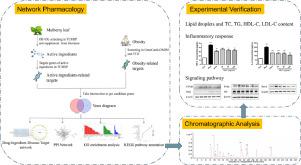Phytomedicine ( IF 6.7 ) Pub Date : 2021-08-25 , DOI: 10.1016/j.phymed.2021.153714 Ruilin Li 1 , Chunli Wang 1 , Yue Chen 1 , Nannan Li 1 , Qirou Wang 1 , Min Zhang 2 , Chengwei He 3 , Haixia Chen 1

|
Background
As one of traditional Chinese medicine, mulberry leaf is abundant in diverse active ingredients and widely used for the treatment of metabolic disease and its complications. However, there are a few of reports on its application in the prevention and treatment of obesity. And the molecular mechanism on the anti-obesity of mulberry leaf are unknown till now.
Purpose
The present study aimed to evaluate the potential ingredients and targets of mulberry leaf and uncover the anti-obesity mechanisms by using the network pharmacology tactics and verify its effect by biological experiments.
Study design
Active ingredients and key targets of mulberry leaf, genes related to obesity were screened through public database. Based on the results of network pharmacology, the flavonoids-enriched fraction of mulberry leaf (MLF) was extracted and composition of this fraction was identified. After that, HepG2 cells model of lipid accumulation was established for verifying the effect of MLF and related mechanisms.
Results
A total of 37 active ingredients in mulberry leaf, 192 predicted biological targets and 8813 obesity-related targets were determined, of which 180 overlapping targets might have obvious curative effects on obesity. The networks showed that mulberry leaf might play a role through key targets, such as AKT, MAPK and IL-6, and regulated PI3K-Akt signaling pathway. Based on HPLC-ESI-QQQ-MS analysis, 13 constituents of MLF were identified, including 9 flavonoids. Furthermore, HepG2 cells model of lipid accumulation was established. The results indicated that MLF treatment could down-regulate the secretion of inflammatory cytokines, as well as clearly inhibited lipid droplets formation and alleviated TC, TG, HDL-C and LDL-C levels. Positive effect was observed on hypolipidemic efficacy due to the regulation of PI3K/Akt/Bcl-xl pathway, as indicated by the amelioration of PI3K, Akt and Bcl-xl gene and protein expression.
Conclusion
This study firstly systematically disclose the multi-ingredients, multi-targets mechanisms of mulberry leaf on obesity by using network pharmacology approach, and validate in HepG2 cells that the protective effect of MLF against obesity involved both inflammation response and lipid metabolism involving PI3K/Akt/Bcl-xl signaling pathway. It provides indications for further mechanistic research of mulberry leaf and also for the development as a potential candidate for the therapy for obese patients.
中文翻译:

结合网络药理学和分子生物学方法研究桑叶对肥胖症的活性成分和潜在机制
背景
作为中药之一,桑叶含有丰富的多种有效成分,广泛用于治疗代谢性疾病及其并发症。然而,关于其在预防和治疗肥胖症方面的应用报道较少。而桑叶抗肥胖的分子机制至今尚不清楚。
目的
本研究旨在利用网络药理学策略评估桑叶的潜在成分和作用靶点,揭示其抗肥胖机制,并通过生物学实验验证其作用。
学习规划
通过公共数据库筛选桑叶的活性成分和关键靶点、肥胖相关基因。根据网络药理学的结果,提取了桑叶 (MLF) 中富含黄酮的部分,并确定了该部分的组成。之后,建立HepG2细胞脂质积累模型以验证MLF的作用及相关机制。
结果
共确定桑叶中37种有效成分、192个预测生物学靶点和8813个肥胖相关靶点,其中180个重叠靶点可能对肥胖有明显疗效。网络表明桑叶可能通过关键目标发挥作用,如 AKT、MAPK 和 IL-6,并调节 PI3K-Akt 信号通路。基于 HPLC-ESI-QQQ-MS 分析,鉴定了 MLF 的 13 种成分,包括 9 种黄酮类化合物。此外,建立了脂质积累的HepG2细胞模型。结果表明,MLF治疗可以下调炎性细胞因子的分泌,并明显抑制脂滴形成,降低TC、TG、HDL-C和LDL-C水平。由于 PI3K/Akt/Bcl-xl 通路的调节,对降血脂功效观察到积极作用,
结论
本研究首次采用网络药理学方法系统揭示桑叶对肥胖的多成分、多靶点机制,并在HepG2细胞中验证MLF对肥胖的保护作用涉及炎症反应和脂质代谢,涉及PI3K/Akt/ Bcl-xl 信号通路。它为桑叶的进一步机理研究以及作为肥胖患者治疗的潜在候选药物的开发提供了指征。










































 京公网安备 11010802027423号
京公网安备 11010802027423号